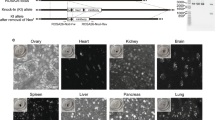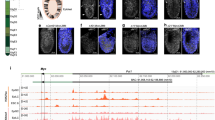Abstract
The establishment and faithful maintenance of epigenetic information in the context of chromatin are crucial for a great number of biologic phenomena, including position effect variegation, Polycomb silencing, X-chromosome inactivation and genomic imprinting. However, mechanisms by which that the correct histone modification patterns propagate into daughter cells during mitotic divisions remain to be elucidated. The partitioning pattern of parental histone H3–H4 tetramers is a critical question toward our understanding of the epigenetic inheritance. In this review, we discuss why the histone H3–H4 tetramer split decision matters.
Similar content being viewed by others
References
Ahmad K, Henikoff S (2002). The histone variant H3.3 marks active chromatin by replication-independent nucleosome assembly. Mol Cell, 9(6): 1191–1200
Allis C D, Jenuwein T, Reinberg D (2006). Epigenetics. New York, Cold Spring Harbor, Cold Spring Harbor Laboratory Press
Annunziato A T (2005). Split decision: what happens to nucleosomes during DNA replication? J Biol Chem, 280(13): 12065–12068
Annunziato A T, Schindler R K, Riggs M G, Seale R L (1982). Association of newly synthesized histones with replicating and nonreplicating regions of chromatin. J Biol Chem, 257(14): 8507–8515
Baxevanis A D, Godfrey J E, Moudrianakis E N (1991). Associative behavior of the histone (H3–H4)2 tetramer: dependence on ionic environment. Biochemistry, 30(36): 8817–8823
Benson L J, Gu Y, Yakovleva T, Tong K, Barrows C, Strack C L, Cook R G, Mizzen C A, Annunziato A T (2006). Modifications of H3 and H4 during chromatin replication, nucleosome assembly, and histone exchange. J Biol Chem, 281(14): 9287–9296
Chuang L S, Ian H I, Koh T W, Ng H H, Xu G, Li B F (1997). Human DNA-(cytosine-5) methyltransferase-PCNA complex as a target for p21WAF1. Science, 277(5334): 1996–2000
English C M, Adkins M W, Carson J J, Churchill M E, Tyler J K (2006). Structural basis for the histone chaperone activity of Asf1. Cell, 127(3): 495–508
English C M, Maluf N K, Tripet B, Churchill M E, Tyler J K (2005). ASF1 binds to a heterodimer of histones H3 and H4: a two-step mechanism for the assembly of the H3–H4 heterotetramer on DNA. Biochemistry, 44(42): 13673–13682
Franklin S G, Zweidler A (1977). Non-allelic variants of histones 2a, 2b and 3 in mammals. Nature, 266(5599): 273–275
Groth A, Rocha W, Verreault A, Almouzni G (2007). Chromatin challenges during DNA replication and repair. Cell, 128(4): 721–733
Grunstein M (1997). Histone acetylation in chromatin structure and transcription. Nature, 389(6649): 349–352
Hake S B, Allis C D (2006). Histone H3 variants and their potential role in indexing mammalian genomes: the “H3 barcode hypothesis”. Proc Natl Acad Sci U S A, 103(17): 6428–6435
Henikoff S (2008). Nucleosome destabilization in the epigenetic regulation of gene expression. Nat Rev Genet, 9(1): 15–26
Henikoff S, Furuyama T, Ahmad K (2004). Histone variants, nucleosome assembly and epigenetic inheritance. Trends Genet, 20(7): 320–326
Hermann A, Goyal R, Jeltsch A (2004). The Dnmt1 DNA-(cytosine-C5)-methyltransferase methylates DNA processively with high preference for hemimethylated target sites. J Biol Chem, 279(46): 48350–48359
Isenberg I (1979). Histones. Annu Rev Biochem, 48: 159–191
Jackson V (1988). Deposition of newly synthesized histones: hybrid nucleosomes are not tandemly arranged on daughter DNA strands. Biochemistry, 27(6): 2109–2120
Jackson V (1990). In vivo studies on the dynamics of histone-DNA interaction: evidence for nucleosome dissolution during replication and transcription and a low level of dissolution independent of both. Biochemistry, 29(3): 719–731
Jackson V, Chalkley R (1981). A new method for the isolation of replicative chromatin: selective deposition of histone on both new and old DNA. Cell, 23(1): 121–134
Jaenisch R (1997). DNA methylation and imprinting: why bother? Trends Genet, 13(8): 323–329
Jones P A, Takai D (2001). The role of DNA methylation in mammalian epigenetics. Science, 293(5532): 1068–1070
Kimura H, Cook P R (2001). Kinetics of core histones in living human cells: little exchange of H3 and H4 and some rapid exchange of H2B. J Cell Biol, 153(7): 1341–1353
Kornberg R D (1974). Chromatin structure: a repeating unit of histones and DNA. Science, 184(139): 868–871
Kornberg R D, Thomas J O (1974). Chromatin structure; oligomers of the histones. Science, 184(139): 865–868
Kouzarides T (2007). Chromatin modifications and their function. Cell, 128(4): 693–705
Lee M G, Villa R, Trojer P, Norman J, Yan K P, Reinberg D, Di Croce L, Shiekhattar R (2007). Demethylation of H3K27 regulates polycomb recruitment and H2A ubiquitination. Science, 318(5849): 447–450
Leffak IM, Grainger R, Weintraub H (1977). Conservative assembly and segregation of nucleosomal histones. Cell, 12(3): 837–845
Li E, Bestor T H, Jaenisch R (1992). Targeted mutation of the DNA methyltransferase gene results in embryonic lethality. Cell, 69(6): 915–926
Luger K, Mäder A W, Richmond R K, Sargent D F, Richmond T J (1997). Crystal structure of the nucleosome core particle at 2.8 A resolution. Nature, 389(6648): 251–260
Margueron R, Justin N, Ohno K, Sharpe M L, Son J, Drury W J 3rd, Voigt P, Martin S R, Taylor W R, De Marco V, Pirrotta V, Reinberg D, Gamblin S J (2009). Role of the polycomb protein EED in the propagation of repressive histone marks. Nature, 461(7265): 762–767
Margueron R, Trojer P, Reinberg D (2005). The key to development: interpreting the histone code? Curr Opin Genet Dev, 15(2): 163–176
Martin C, Zhang Y (2005). The diverse functions of histone lysine methylation. Nat Rev Mol Cell Biol, 6(11): 838–849
Martin C, Zhang Y (2007). Mechanisms of epigenetic inheritance. Curr Opin Cell Biol, 19(3): 266–272
Nakatani Y, Ray-Gallet D, Quivy J P, Tagami H, Almouzni G (2004). Two distinct nucleosome assembly pathways: dependent or independent of DNA synthesis promoted by histone H3.1 and H3.3 complexes. Cold Spring Harb Symp Quant Biol, 69: 273–280
Nakayama J, Rice J C, Strahl B D, Allis C D, Grewal S I (2001). Role of histone H3 lysine 9 methylation in epigenetic control of heterochromatin assembly. Science, 292(5514): 110–113
Natsume R, Eitoku M, Akai Y, Sano N, Horikoshi M, Senda T (2007). Structure and function of the histone chaperone CIA/ASF1 complexed with histones H3 and H4. Nature, 446(7133): 338–341
Olins A L, Olins D E (1974). Spheroid chromatin units (v bodies). Science, 183(4122): 330–332
Ong S E, Blagoev B, Kratchmarova I, Kristensen D B, Steen H, Pandey A, Mann M (2002). Stable isotope labeling by amino acids in cell culture, SILAC, as a simple and accurate approach to expression proteomics. Mol Cell Proteomics, 1(5): 376–386
Prior C P, Cantor C R, Johnson E M, Allfrey V G (1980). Incorporation of exogenous pyrene-labeled histone into Physarum chromatin: a system for studying changes in nucleosomes assembled in vivo. Cell, 20(3): 597–608
Probst A V, Dunleavy E, Almouzni G (2009). Epigenetic inheritance during the cell cycle. Nat Rev Mol Cell Biol, 10(3): 192–206
Ray-Gallet D, Almouzni G (2010). Molecular biology. Mixing or not mixing. Science, 328(5974): 56–57 PMID:20360101
Riggs A D, Martiennssen R A, Russo V E A (1996). Epigenetic Mechanisms of Gene Regulation. New York: Cold Spring Harbor Laboratory Press
Russev G, Hancock R (1981). Formation of hybrid nucleosomes cantaining new and old histones. Nucleic Acids Res, 9(16): 4129–4137
Seale R L (1976). Studies on the mode of segregation of histone nu bodies during replication in HeLa cells. Cell, 9(3): 423–429
Sharif J, Muto M, Takebayashi S, Suetake I, Iwamatsu A, Endo T A, Shinga J, Mizutani-Koseki Y, Toyoda T, Okamura K, Tajima S, Mitsuya K, Okano M, Koseki H (2007). The SRA protein Np95 mediates epigenetic inheritance by recruiting Dnmt1 to methylated DNA. Nature, 450(7171): 908–912
Shi Y, Lan F, Matson C, Mulligan P, Whetstine J R, Cole P A, Casero R A, Shi Y (2004). Histone demethylation mediated by the nuclear amine oxidase homolog LSD1. Cell, 119(7): 941–953
Tagami H, Ray-Gallet D, Almouzni G, Nakatani Y (2004). Histone H3.1 and H3.3 complexes mediate nucleosome assembly pathways dependent or independent of DNA synthesis. Cell, 116(1): 51–61
Weintraub H, Worcel A, Alberts B (1976). A model for chromatin based upon two symmetrically paired half-nucleosomes. Cell, 9(3): 409–417
Wu R S, Tsai S, Bonner W M (1982). Patterns of histone variant synthesis can distinguish G0 from G1 cells. Cell, 31(2 Pt 1): 367–374
Xu M, Long C, Chen X, Huang C, Chen S, Zhu B (2010). Partitioning of histone H3–H4 tetramers during DNA replication-dependent chromatin assembly. Science, 328(5974): 94–98
Yamasu K, Senshu T (1990). Conservative segregation of tetrameric units of H3 and H4 histones during nucleosome replication. J Biochem, 107(1): 15–20
Zee B M, Levin R S, Xu B, LeRoy G, Wingreen N S, Garcia B A (2010). In vivo residue-specific histone methylation dynamics. J Biol Chem, 285(5): 3341–3350
Author information
Authors and Affiliations
Corresponding author
Rights and permissions
About this article
Cite this article
Wu, H., Zhu, B. Split decision: why it matters?. Front. Biol. 6, 88–92 (2011). https://doi.org/10.1007/s11515-011-1040-y
Received:
Accepted:
Published:
Issue Date:
DOI: https://doi.org/10.1007/s11515-011-1040-y




